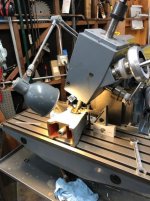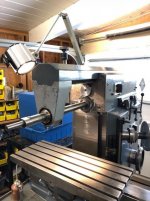rklopp
Diamond
- Joined
- Feb 27, 2001
- Location
- Redwood City, CA USA
My Aciera F5 came with an overarm support from another machine. The bearing bore did not line up with the horizontal spindle axis. Rather than spend a whole ton of time scraping the interface between the overarm support and the overarm, I decided to accommodate the 0.015" offset by making a new bushing and boring it in situ. Scraping the interface would have involved trying to get at least four, and preferably five, angled surfaces to hit at once while getting the bore lined up correctly. The bottom of the overarm is shaped a lot like a Schaublin or old-style Hardinge lathe bed, so there are two angled surfaces plus a flat. The overarm bearing support has five seating surfaces, because there are big hollows between the each pair of angled flats on the side, as can be seen in the diagram.
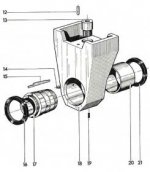
I got a piece of 3" cored SAE 660 bearing bronze off eBay and went at it. I got the taper fit by bluing to good contact with the tapered seat in the overarm support. The seat is a light press fit in the overarm support casting, so it was easiest to press is out to use it as a gauge. I cut the M58 x 1.25 threads using a single-profile thread mill in the FP2NC. I got lucky, because the two Aciera nuts had slightly different pitch diameter. I cut the thread oversize, and found one of the nuts already fit the oversize male thread, while the other would not.
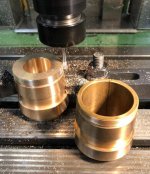
Then, I bored the bushing by butting the overarm support against an angle plate clamped to the mill's table and feeding the Y axis with a boring head in the spindle. This slide the overarm dovetail in its mounting, effectively pushing the overarm support and bushing toward the spindle. I kept the overarm support locks lightly snug to act as gibs.

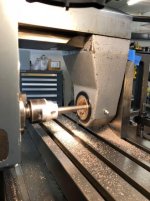

I got a piece of 3" cored SAE 660 bearing bronze off eBay and went at it. I got the taper fit by bluing to good contact with the tapered seat in the overarm support. The seat is a light press fit in the overarm support casting, so it was easiest to press is out to use it as a gauge. I cut the M58 x 1.25 threads using a single-profile thread mill in the FP2NC. I got lucky, because the two Aciera nuts had slightly different pitch diameter. I cut the thread oversize, and found one of the nuts already fit the oversize male thread, while the other would not.

Then, I bored the bushing by butting the overarm support against an angle plate clamped to the mill's table and feeding the Y axis with a boring head in the spindle. This slide the overarm dovetail in its mounting, effectively pushing the overarm support and bushing toward the spindle. I kept the overarm support locks lightly snug to act as gibs.




